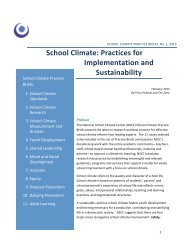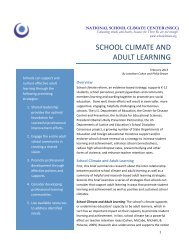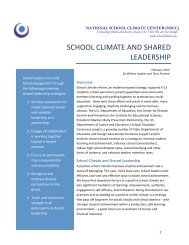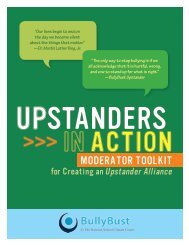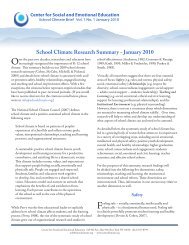two wrongs don't make a right - National School Climate Center
two wrongs don't make a right - National School Climate Center
two wrongs don't make a right - National School Climate Center
You also want an ePaper? Increase the reach of your titles
YUMPU automatically turns print PDFs into web optimized ePapers that Google loves.
HARSH RESPONSES TO BULLYING & THE EXPANSION OF THE SCHOOL-TO-PRISON PIPELINE<br />
and more productive learning environments. Instead, just as with other student disciplinary matters, harsh<br />
responses to bullying usually only <strong>make</strong> matters worse, and create new problems, by putting the “bully” on a<br />
fast track toward dropping out and winding up in jail.<br />
Indeed, zero-tolerance responses can actually have the unintended effects of strengthening a bully’s resolve and<br />
further victimizing the recipient of his or her aggression. And where harsh responses are the norm, or even a<br />
regular practice, there can be a “chilling effect” on teachers and other adults even reporting bullying because of<br />
the fear that the consequences will be more severe than is appropriate.<br />
Additionally, harsh responses to bullying can actually wind up harming the very students they are intended to<br />
protect. For example, by reinforcing the zero-tolerance approach and expanding the definition of “bullying,”<br />
these new laws and policies put victims of bullying, and particularly LGBTQ youth, at heightened risk. In fact, the<br />
self-preservation techniques used by many LGBTQ youth in response to harassment have led them to become<br />
victims of this zero-tolerance approach. 67 Indeed, many students identified as “bullies” have previously been the<br />
victims of bullying, and vice versa. 68 Moreover, the use of harsh disciplinary actions typically leads to increased<br />
reporting, which has inadvertently “outed” many LGBTQ youth to their parents or peers, and can be both<br />
traumatic and dangerous for these young people. 69<br />
Another major flaw in the use of harsh disciplinary responses for bullying is that this approach is based on the<br />
premise that “bullies” are “bad apples” that need to be removed in order for schools to be safe. However, as the<br />
<strong>School</strong>-to-Prison Pipeline movement has taught us, the get-tough approach to weeding out students perceived<br />
as dangerous or disruptive – the so-called “bad kids” – is actually deeply harmful to everyone in a school. When<br />
anti-bullying efforts lead to zero tolerance and police involvement in schools, they only add to the oppression<br />
and alienation that students within those schools experience. That, in turn, will only lead to more hostile,<br />
and less healthy, school environments in which the relationships between students and adults are worsened,<br />
students dread even going to school, and the very behaviors we hope to avoid – violence, disruptions,<br />
harassment, bullying – are more likely to occur. In other words, the use of zero-tolerance measures to address<br />
bullying merely reinforces and perpetuates a downward spiral of excessive punishments, adult-youth conflict,<br />
and deterioration of school climates. Thus, unless policy<strong>make</strong>rs are mindful of the systemic effects of their<br />
bullying interventions, they will create school environments that are less inclusive, less nurturing and, ultimately,<br />
less safe.<br />
In short, while this push to “get tough” on bullies was intended to protect victims, and especially LGBTQ youth,<br />
it will instead have the opposite effect, and needlessly harm countless young people, sending both LGBTQ and<br />
non-LGBTQ youth into the <strong>School</strong>-to-Prison Pipeline.<br />
10 TWO WRONGS DON’T MAKE A RIGHT




